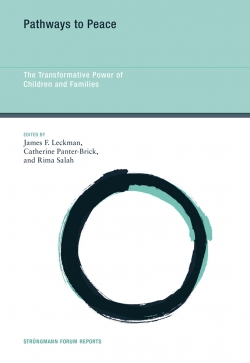Creating Effective Programs & Policies to Reduce Violence & Promote Peace
Creating Effective Programs & Policies to Reduce Violence & Promote Peace
Conceptional Framework
Peace is an opportunity, including internal awareness, which allows human beings, individually and collectively, to pursue their lives in a meaningful way to their fullest potential, and contributing to the realization of universal human rights, freedom, justice, and oneness of humanity. During the first years of life until the transition to primary school, it is crucial for a child to have successfully developed motor, social, cognitive, emotional, spiritual, and moral skills and awareness, as well as language, literacy, communication, self-identity, and cultural development. The early life bonds impact neurology in ways that have multigenerational impact. The Oxytocin System, for example, is heavily involved in the process of bonding and nurturing during the early stages in life. It is also associated with capacities for trust, empathy, and reaction to stress, and can influence personal agency and motivation as well as dynamics of social inclusion and prosocial behavior.
Peace, Early Childhood, and Policy: What We Know and What Are the Challenges
There are a variety of difficulties in linking the micro and macro level issues of peace, early childhood, and policy. There needs to be a better understanding of the link between macro conditions of conflict and war that can be destructive and developmentally harmful to children and families, versus macro conditions that facilitate stability and safety to promote childhood and family security, safety, and growth.
Theory of Change: The Wellbeing of Children is Fundamental to Peace
Simply stated, children need to be protected in order to promote peace, a concept that was addressed in the universally ratified Convention on the Rights of the Child. Children, even young children, have a voice and agency in promoting peace. Rights, support, and protection of children are all connected to peacebuilding, and children suffer from structural violence when they do not receive adequate stimulation, support, and protection during sensitive periods of growth. Supporting healthy brain development early will yield adult capabilities and opportunities that will hopefully narrow social inequity and economic exclusion, reducing structural violence. Children should be invited to participate in developing policies and programs, and childhood agency should be acknowledged.
New Approaches to the Use of Knowledge for Policy, Global Citizenship and the Culture of Peace
These new approaches enables children and adults to think and act in ways that forge more just, peaceful, tolerant, and inclusive societies. The foundation for global citizenship laid during childhood, is where children learn compassion and empathy and the UN report on education places global citizenship as one of three priorities for the world community.
Ecological Paradigms of Nested Systems Overlaid by Networks of Association
Urie Bronfenbrenner’s ecological paradigm to explain human development explains that children develop in four levels of a nested system: the microsystem, mesosystem, exosystem, and the macrosystem. In early childhood, the microsystem has the most significant direct influence on development and the more distal the context, the more indirect its influence. This idea kind of breaking down as we understand the impact of structural violence and as new technology connects people more, contexts of the macrosystem are no longer distal. In context of peacebuilding and early childhood, rethinking the nested systems brings greater complexity to our understanding of proximal and distal contexts that influence child development.
Capabilities-based Approach to Practice, Policy, and Programs
Intergroup competition and conflict creates negative stereotypes and hostility. In the Robber’s Cave experiment, 11yr old boys were divided into two groups. When competing against each other and awards for winners, there was good in-group cohesion but also intergroup hostility; when forced to work together for common goals, interdependence and cooperation created positive attitudes towards toward the other group and reduced prejudice. Religious groups may be important partners in pushing forward ECD programs. For example, in many parts of Africa, they run some of the largest hospitals or healthcare facilities, the major institutions in the area. More broadly, there is a positive role for meaning-making and value-sustaining human associations as creative and supporting partners with research and government.
Media and Education, in Addition to Family, Are Powerful Channels to Promote Peace through Early Childhood
Media literacy builds self-awareness and awareness of others, and reduces bias and stereotyping, building resistance to propaganda. Through media literacy, children are taught to analyze media content and read between lines, thinking more critically and are encouraged to produce their own media images and have greater awareness of the various forces in society.
Refining the Translation of Knowledge
Knowledge generators, translators, and consumers are a bidirectional flow of information. Translation works best if there is joint work by scientists and policy makers, involving bilateral info sharing, so policy makers develop “ownership” of that knowledge and its application. It is important to draw examples from the non-Western Majority World with a promising strategy of peacebuilding being to spread the message through non-experts into mainstream culture. Translation should not be done not by scientists or politicians, but rather by musicians, artists, bloggers, and young students. This process is peacebuilding exemplifies transparency and provides model for communication between different groups and joint problem solving.
Recommendations for Academics
Indicators and evaluative measures for measuring peace need to be gathered from grounded theory and practical research on peacebuilding. There is still no expected outcome of how differences in early childhood backgrounds directly impact peaceful lives and communities. There is also not enough research about the reversibility of harm, which may inform ethical issues of resource allocation. We need to work on linking the biology of human development to group and intergroup behavior while also mapping the field of existing practices and effective methodology and knowledge accumulated in field of peacebuilding by early childhood peace agencies.
Recommendations for Policy
The third phase of the World Program for Human Rights Education is to focus on early childhood and peace education. Special representatives of the Secretary General on Violence against Children should take up the issue of early childhood intervention as their thematic report to the General Assembly. New knowledge about child development and peace needs to be translated into concrete policies, such as UN Convention on early childhood and peace. Mayors for Peace initiative, currently focused in the “total abolition of all nuclear weapons by 2020,” could be used to advance peace education and could partner with Peace Messenger Cities and the City of Sanctuary Movement.
Recommendations for Practitioners
Practitioners should incorporate education for peace in early childhood formal education and use peer mediation programs in primary schools. They should also incorporate institutional peace education through socio economic development agencies programs, especially for those who work in providing basic health services in conflict areas and underdeveloped settings as well as regulate exposure to violence by media and social media in formative years via extensive work with communities, families, and media outlets, and reach out to fathers and men and engage them in a pathway between early childhood and peace.
Recommendations for Families and Communities
One recommendation would be to educate children on values, attitudes, modes of behavior and ways of life that enable them to resolve disputes peacefully with nondiscrimination and tolerance, with respect for human dignity and social justice. It is also encouraged to involve children in activities designed to instill in them the values and goals of a culture of peace; empower them to be agents of change and ensure the equality of access to education for women, especially girls, and enhance the social capital of mothers.
JOIN THE CONVERSATION
For breaking news and to stay connected, follow us on social media. Sign up to get our E-News delivered straight to your inbox.

